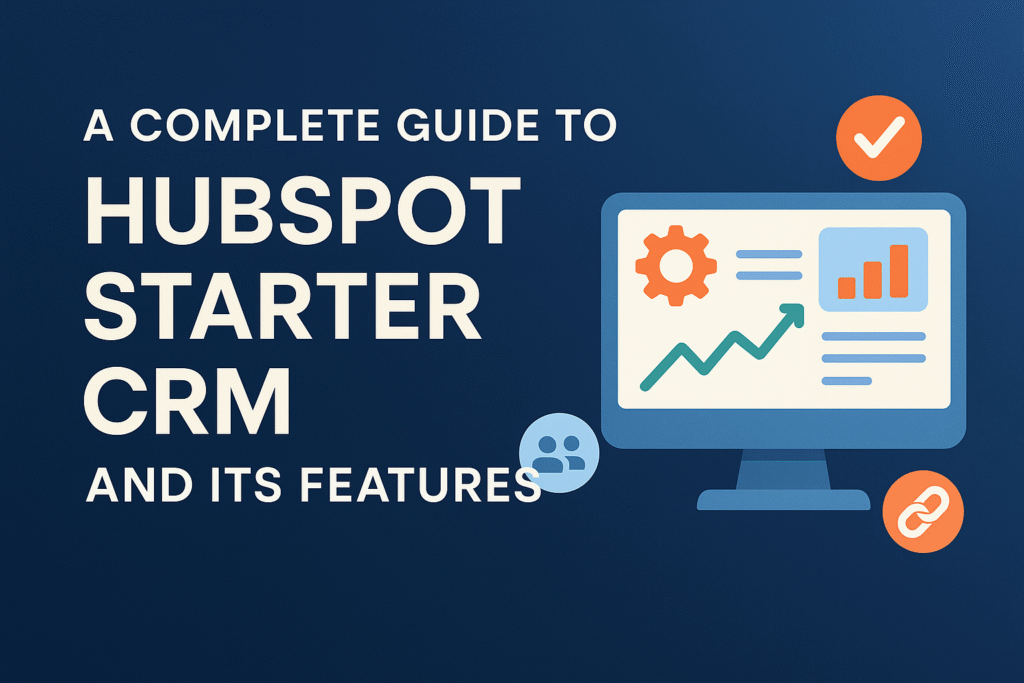A Complete Guide to HubSpot Starter CRM and Its Features

If you’re new to HubSpot, it might feel like you’ve just opened a giant toolbox filled with endless buttons, dashboards, and features. But don’t worry — this HubSpot Starter CRM Guide will help you go from beginner to confident user faster than you think.
Whether your goal is to improve inbound marketing, manage leads more effectively, or automate sales processes, HubSpot Starter CRM is designed to make your work easier, smarter, and more efficient.
Step 1: Understand What HubSpot CRM Does
HubSpot is an all-in-one inbound marketing, sales, and CRM platform that helps businesses attract visitors, convert leads, and close customers.
The platform is divided into five main “Hubs”, each serving a specific purpose:
- Marketing Hub – Email campaigns, SEO tools, landing pages, social media scheduling.
- Sales Hub – Contact management, deal tracking, meeting scheduling, pipelines.
- Service Hub – Customer support tickets, chatbots, and a self-service knowledge base.
- CMS Hub – Website hosting, drag-and-drop page building, and content optimization.
- Operations Hub – Data syncing, advanced automation, and integrations with other tools.
💡 Pro Tip: Even if you only use the free CRM, you still get access to many core features that can replace several different tools at once.
Step 2: Set Up Your HubSpot Starter Account
Getting started is simple:
- Sign up at hubspot.com for a free account.
- Verify your email and complete your business profile.
- Import your contacts (CSV file or from other CRMs).
- Connect your email and calendar to track conversations automatically.
📌 Tip: Start with the free CRM first — you can always upgrade to paid hubs later as your needs grow.
Step 3: Learn the HubSpot Dashboard
Once logged in, take some time to explore the main sections:
- Contacts – Store, manage, and segment all customer and prospect data.
- Conversations – Central inbox for live chat, email, and form submissions.
- Marketing Tools – Manage email campaigns, forms, ads, and more.
- Reports – Track analytics for marketing, sales, and service activities.
Step 4: Create Your First Campaign
HubSpot’s drag-and-drop tools make it easy to launch your first campaign:
- Set a Goal – Newsletter sign-ups, webinar registrations, product demos, etc.
- Build a Landing Page – Use pre-built templates or customize your own.
- Add a Lead Form – Capture visitor details automatically in your CRM.
- Automate Follow-Ups – Send personalized emails using Workflows.
Step 5: Accelerate Your Learning with HubSpot Academy
HubSpot Academy offers free certifications and step-by-step tutorials on marketing, sales, and CRM tools.
Recommended beginner courses:
- HubSpot CRM for Beginners
- Inbound Marketing Certification
- Email Marketing Certification
📌 Visit HubSpot Academy to start learning faster.
Step 6: Track, Optimize, and Automate Your Workflows
- Track performance using built-in analytics dashboards.
- Automate repetitive tasks like lead scoring, follow-up emails, and pipeline updates.
- Run A/B tests on landing pages, forms, and subject lines to improve conversions.
💡 Pro Tip: Automation in HubSpot can save hours per week while ensuring you never miss a lead or follow-up opportunity.
Conclusion
At first glance, HubSpot Starter CRM might seem overwhelming — but once you break it down into its essential tools and features, you’ll see it’s one of the most powerful (and user-friendly) CRMs available.
Start with the basics:
- Set up your free CRM.
- Learn your dashboard.
- Launch a simple campaign.
Combine this with HubSpot Academy’s free courses, and you’ll be running professional inbound campaigns like a pro in no time.

